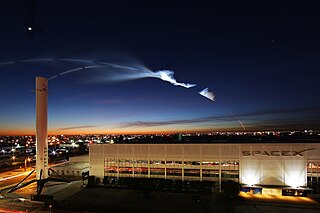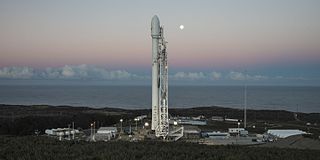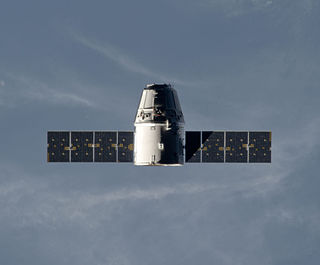
Space Exploration Technologies Corp., trading as SpaceX, is a private American aerospace manufacturer and space transportation services company headquartered in Hawthorne, California. It was founded in 2002 by Elon Musk with the goal of reducing space transportation costs to enable the colonization of Mars. SpaceX has developed several launch vehicles and the Dragon spacecraft.

Launch Complex 39 (LC-39) is a rocket launch site at the John F. Kennedy Space Center on Merritt Island in Florida, United States. The site and its collection of facilities were originally built for the Apollo program and later modified for the Space Shuttle program.

Falcon 9 is a partially reusable two-stage-to-orbit medium lift launch vehicle designed and manufactured by SpaceX in the United States. It is powered by Merlin engines, also developed by SpaceX, burning cryogenic liquid oxygen and rocket-grade kerosene (RP-1) as propellants. Its name is derived from the Millennium Falcon and the nine engines of the rocket's first stage. The rocket evolved with versions v1.0 (2010–2013), v1.1 (2013–2016), v1.2 "Full Thrust" (2015–present), including the Block 5 Full Thrust variant, flying since May 2018. Unlike most rockets, which are expendable launch systems, since the introduction of the Full Thrust version, Falcon 9 is partially reusable, with the first stage capable of re-entering the atmosphere and landing back vertically after separating from the second stage. This feat was achieved for the first time on flight 20 with the v1.2 version in December 2015.

The SpaceX Dragon is a reusable cargo spacecraft developed by SpaceX, an American private space transportation company. Dragon is launched into orbit by the company's Falcon 9 launch vehicle.

Space Launch Complex 4 (SLC-4) is a launch and landing site at Vandenberg Air Force Base with two pads, both of which are used by SpaceX for Falcon 9 launch operations; operating as Landing Zone 4 (LZ-4) for SpaceX landings.

The Dragon Spacecraft Qualification Unit was a boilerplate version of the Dragon spacecraft manufactured by SpaceX. After using it for ground tests to rate Dragon's shape and mass in various tests, SpaceX launched it into low Earth orbit on the maiden flight of the Falcon 9 rocket, on June 4, 2010. SpaceX used the launch to evaluate the aerodynamic conditions on the spacecraft and performance of the carrier rocket in a real-world launch scenario, ahead of Dragon flights for NASA under the Commercial Orbital Transportation Services program. The spacecraft orbited the Earth over 300 times before decaying from orbit and reentering the atmosphere on 27 June.

SpaceX CRS-1, also known as SpX-1, was the third flight for Space Exploration Technologies Corporation's (SpaceX) uncrewed Dragon cargo spacecraft, the fourth overall flight for the company's two-stage Falcon 9 launch vehicle, and the first SpaceX operational mission under their Commercial Resupply Services contract with NASA. The launch occurred on 7 October 2012 at 20:34 EDT.

Launch vehicles often undergo system tests before they are used for spaceflight. A wet dress rehearsal (WDR) and a more extensive static fire are tests of a fully integrated space launch vehicle and its associated ground support equipment (GSE) prior to launch. The spacecraft or payload may or may not be attached to the launch vehicle during the WDR or static fire, but sufficient elements of the rocket and all relevant ground support equipment are in place to help verify that the rocket is ready for flight, with the goal of allowing problems to be seen prior to the actual launch.

SpaceX CRS-8, also known as SpX-8, was a Commercial Resupply Service mission to the International Space Station (ISS) which was launched on April 8, 2016, at 20:43 UTC. It was the 23rd flight of a Falcon 9 rocket, the tenth flight of a Dragon cargo spacecraft and the eighth operational mission contracted to SpaceX by NASA under the Commercial Resupply Services program. The capsule carried over 3,100 kilograms (6,800 lb) of cargo to the ISS including the Bigelow Expandable Activity Module (BEAM), a prototype inflatable space habitat delivered in the vehicle's trunk, which will be attached to the station for two years of in-orbit viability tests.

As of December 2017, SpaceX uses three leased orbital launch sites: Launch Complex 39A of the Kennedy Space Center, Space Launch Complex 40 at Cape Canaveral Air Force Station, both in Florida, and Space Launch Complex 4E of the Vandenberg Air Force Base in California. Space Launch Complex 40 was damaged in the Amos-6 accident on September 2016 and repair work was completed by December 2017. SpaceX is also building a commercial-only launch facility at the Boca Chica site near Brownsville, Texas and is expected to be operational no earlier than 2019.

Falcon 9 v1.1 was the second version of SpaceX's Falcon 9 orbital launch vehicle. The rocket was developed in 2011–2013, made its maiden launch in September 2013, and its final flight in January 2016. The Falcon 9 rocket was fully designed, manufactured, and operated by SpaceX. Following the second Commercial Resupply Services (CRS) launch, the initial version Falcon 9 v1.0 was retired from use and replaced by the v1.1 version.

Dragon 2 is a class of reusable spacecraft developed and manufactured by U.S. aerospace manufacturer SpaceX, intended as the successor to the Dragon cargo spacecraft. The spacecraft launches atop a Falcon 9 Block 5 rocket and returns via ocean splashdown.

The Falcon 9 first-stage landing tests were a series of controlled-descent flight tests conducted by SpaceX between 2013 and 2016. Since 2017, the first stage of Falcon 9 missions has been routinely landed if the rocket performance allowed it, and if SpaceX chose to recover the stage.

SpaceX CRS-10, also known as SpX-10, was a Dragon Commercial Resupply Service mission to the International Space Station (ISS) which launched on 19 February 2017. The mission was contracted by NASA as part of its Commercial Resupply Services program and was launched by SpaceX aboard the 30th flight of the Falcon 9 rocket. The mission ended on 19 March 2017 when the Dragon spacecraft left the ISS and safely returned to Earth.

SpaceX CRS-13, also known as SpX-13, was a Commercial Resupply Service mission to the International Space Station launched on 15 December 2017. The mission was contracted by NASA and is flown by SpaceX. It was the second mission to successfully reuse a Dragon capsule, previously flown on CRS-6. The first stage of the Falcon 9 Full Thrust rocket was the previously flown, "flight-proven" core from CRS-11. The first stage returned to land at Cape Canaveral's Landing Zone 1 after separation of the first and second stage.

Falcon 9 Full Thrust is a partially reusable medium-lift launch vehicle, designed and manufactured by SpaceX. Designed in 2014–2015, Falcon 9 Full Thrust began launch operations in December 2015. As of 7 March 2020 Falcon 9 Full Thrust had performed 62 launches.

Landing Zone 1 and Landing Zone 2, also known as LZ-1 and LZ-2 respectively, are landing facilities for recovering components of SpaceX's VTVL reusable launch vehicles. LZ-1 and LZ-2 were built on land leased in February 2015 from the United States Air Force, on the site of the former Cape Canaveral Air Force Station Launch Complex 13. SpaceX built Landing Zone 2 at the facility to have a second landing pad, allowing two Falcon Heavy boosters to land simultaneously.

Dragon 2 In-Flight Abort Test was a test of the Crew Dragon abort system. The test was conducted on 19 January 2020. It involved the launch of a Falcon 9 from Launch Complex 39A on a suborbital trajectory, followed by an inflight abort of Crew Dragon at max-Q. While the capsule successfully escaped, booster B1046 was destroyed as intended.























